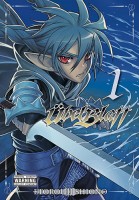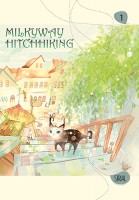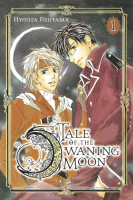My News and Reviews
Last week, the most recent manga giveaway at Experiments in Manga was posted. The winner will be announced on Wednesday, so there are still a couple of days left to enter for a chance to win the first volume of Assassination Classroom. All you have to do is tell me about your favorite teacher from a manga. I also posted two reviews last week. The first review was of Yaya Sakuragi’s boys’ love manga Hide and Seek, Volume 2. The series continues to be one of her strongest; I’m really enjoying it. The second review was of Taiyo Fujii’s novel Gene Mapper, the most recent release from the Haikasoru. Gene Mapper is a great example of realistic near future science featuring thought-provoking information and bio-technologies.
Organization Anti-Social Geniuses has been posting some great manga-related content recently, including a conversation with manga translator Amanda Haley about Book Walker and the translation field. A new manga feature at OASG was announced for the summer as well: Shoujo You Should Know, the first column focusing on CLAMP’s short series Wish. And speaking of shoujo manga, Shojo Beat is celebrating its tenth anniversary. Among other thing, the imprint is posting brief interviews with some of its creators. First up was Maki Minami followed by Yun Kouga. Over at Things We Lost at Dusk, Alicia posted and interesting essay about gender, identity, and language, specifically in regards to Moto Hagio’s manga They Were Eleven.
Last but not least, I would like to draw everyone’s attention to Chromatic Press’ Kickstarter project to help support and fund Sparkler Monthly‘s third year. I am a huge fan of Sparkler Monthly and everything else that Chromatic Press is doing. (Experiments in Manga’s Chromatic Press tag is filled with my love, reviews, and features.) The content, creators, and everyone else involved are all fantastic. So, please check out Sparkler Monthly. Most of the comics, prose, and audio, is currently available for free online. And if you like what you see, please consider pledging to the Sparkler Monthly Kickstarter project if you can. Every little bit helps. The work being done at Chromatic Press is spectacular; I sincerely hope that Sparkler Monthly and the publisher’s other efforts are able to continue.
Quick Takes
 Awkward Silence, Volume 4 by Hinako Takanaga. Some of the very first boys’ love manga that I ever read we’re by Takanaga. I soon began counting her among my favorite creators working in the genre and so was quite pleased when Sublime licensed Awkward Silence. The fourth volume in the series was actually released in English quite a while ago, but I only recently realized that I hadn’t actually read it yet, probably because Awkward Silence isn’t particularly memorable. It’s not a bad manga, and there are plenty of things that I like about it—Takanaga’s artwork is great, for one, as are some of the characters—but overall, Awkward Silence somehow manages to come across as generic. For the most part it’s enjoyable and sometimes even sweet, but the series just doesn’t stand out. Initially, I was under the impression that the fourth volume was the end, but apparently it’s an ongoing series. Being something of a Takanaga completist I’ll likely read any subsequent volumes, but otherwise I don’t know that I would feel compelled to seek the series out.
Awkward Silence, Volume 4 by Hinako Takanaga. Some of the very first boys’ love manga that I ever read we’re by Takanaga. I soon began counting her among my favorite creators working in the genre and so was quite pleased when Sublime licensed Awkward Silence. The fourth volume in the series was actually released in English quite a while ago, but I only recently realized that I hadn’t actually read it yet, probably because Awkward Silence isn’t particularly memorable. It’s not a bad manga, and there are plenty of things that I like about it—Takanaga’s artwork is great, for one, as are some of the characters—but overall, Awkward Silence somehow manages to come across as generic. For the most part it’s enjoyable and sometimes even sweet, but the series just doesn’t stand out. Initially, I was under the impression that the fourth volume was the end, but apparently it’s an ongoing series. Being something of a Takanaga completist I’ll likely read any subsequent volumes, but otherwise I don’t know that I would feel compelled to seek the series out.
 Just So Happens by Fumio Obata. Originally published in the United Kingdom in 2014, Just So Happens was recently released in North America. Yumiko is a designer who left Japan to study and work in London. From time to time she returns to Japan to visit her family, but she is largely satisfied with her life in England. But Yumiko’s most recent trip to Japan is different. Her father unexpectedly died in a mountain climbing accident and she wants and needs to be there for his funeral. In part drawing inspiration from the imagery and symbolism of Noh theater, Just So Happens is a beautiful and subtle work about family, grief, identity, and coming to terms with past decisions. Obata’s watercolor illustrations are absolutely lovely and very effective in conveying the work’s quiet, introspective atmosphere. The story itself is fairly simple and is emotionally resonant without being overly dramatic. Much like Yumiko, Obata is himself a Japanese artist who has made England his home, so while the graphic novel isn’t necessarily autobiographical, Just So Happens still feels very personal.
Just So Happens by Fumio Obata. Originally published in the United Kingdom in 2014, Just So Happens was recently released in North America. Yumiko is a designer who left Japan to study and work in London. From time to time she returns to Japan to visit her family, but she is largely satisfied with her life in England. But Yumiko’s most recent trip to Japan is different. Her father unexpectedly died in a mountain climbing accident and she wants and needs to be there for his funeral. In part drawing inspiration from the imagery and symbolism of Noh theater, Just So Happens is a beautiful and subtle work about family, grief, identity, and coming to terms with past decisions. Obata’s watercolor illustrations are absolutely lovely and very effective in conveying the work’s quiet, introspective atmosphere. The story itself is fairly simple and is emotionally resonant without being overly dramatic. Much like Yumiko, Obata is himself a Japanese artist who has made England his home, so while the graphic novel isn’t necessarily autobiographical, Just So Happens still feels very personal.
 Servamp, Volumes 1-2 by Strike Tanaka. From my admittedly limited exposure, my impression of manga originating from Comic Gene is that they tend to have a lot of style without necessarily making a lot of sense. So far, that seems to be the case with Servamp as well. The first two volumes are entertaining, even enjoyable, but I’d be hard pressed to actually explain everything that is going on in the manga. Granted, Mahiru, the series protagonist, doesn’t really know what’s going on either, and the characters who do aren’t being particularly forthcoming. Mahiru likes to keep things simple, which basically means that he ends up doing up anything and everything himself rather than involving other people. And so he’s more or less taken on the responsibility of saving the world, or at least saving humans from the vampires who would kill them all. Mahiru does have some help though, namely an exceptionally lazy but supposedly extremely powerful vampire known as Sleepy Ash, as well as a few other allies. Though it has yet to be seen just how far those allies can really be trusted.
Servamp, Volumes 1-2 by Strike Tanaka. From my admittedly limited exposure, my impression of manga originating from Comic Gene is that they tend to have a lot of style without necessarily making a lot of sense. So far, that seems to be the case with Servamp as well. The first two volumes are entertaining, even enjoyable, but I’d be hard pressed to actually explain everything that is going on in the manga. Granted, Mahiru, the series protagonist, doesn’t really know what’s going on either, and the characters who do aren’t being particularly forthcoming. Mahiru likes to keep things simple, which basically means that he ends up doing up anything and everything himself rather than involving other people. And so he’s more or less taken on the responsibility of saving the world, or at least saving humans from the vampires who would kill them all. Mahiru does have some help though, namely an exceptionally lazy but supposedly extremely powerful vampire known as Sleepy Ash, as well as a few other allies. Though it has yet to be seen just how far those allies can really be trusted.
 Übel Blatt, Omnibus 1 (equivalent to Volumes 2-3) by Etorouji Shiono. Although there was a fair amount that bothered me about the initial omnibus of Übel Blatt, the series still showed some potential and I was curious to see where it might go. I am happy to be able to say that the most recent omnibus is an improvement. There’s still gratuitous nudity and sexual content, but it doesn’t seem nearly as out-of-place as it was at the beginning of the series. The fact that many of women are dressed in ridiculously revealing and impractical clothing is even lampshaded at one point when Peepi celebrates the fact that she gets to wear “normal clothes.” In general, the female characters actually are treated a little better and are slightly more developed as individuals in Übel Blatt, Omnibus 1, but sadly not to the extent that I really want to see. To be fair, though, most of the characters seem to lack depth. The action sequences and artwork remain fairly strong, and I do largely like the lead, but for the most part Übel Blatt just isn’t connecting with me. This does surprise me somewhat as I usually really enjoy dark fantasy and tales of revenge.
Übel Blatt, Omnibus 1 (equivalent to Volumes 2-3) by Etorouji Shiono. Although there was a fair amount that bothered me about the initial omnibus of Übel Blatt, the series still showed some potential and I was curious to see where it might go. I am happy to be able to say that the most recent omnibus is an improvement. There’s still gratuitous nudity and sexual content, but it doesn’t seem nearly as out-of-place as it was at the beginning of the series. The fact that many of women are dressed in ridiculously revealing and impractical clothing is even lampshaded at one point when Peepi celebrates the fact that she gets to wear “normal clothes.” In general, the female characters actually are treated a little better and are slightly more developed as individuals in Übel Blatt, Omnibus 1, but sadly not to the extent that I really want to see. To be fair, though, most of the characters seem to lack depth. The action sequences and artwork remain fairly strong, and I do largely like the lead, but for the most part Übel Blatt just isn’t connecting with me. This does surprise me somewhat as I usually really enjoy dark fantasy and tales of revenge.




